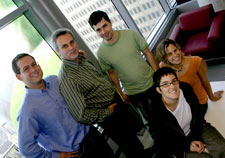Wireless group rooted in Concordia

The faces behind Île sans fil. Standing: Michael Lenczner, Michael Longford and David Vincelli. Seated are Miriam Verburg, Fine Arts alumna, and Alison Powell.
Photo by Jason Gondziola
To wireless laptop users in Montreal, the name Île Sans Fil should by now be a household name – or at least an utterance heard in Montreal’s most tech-savvy circles.
The non-profit volunteer wireless group has made the leap from a small operation of obscure open source coders to a full-blown Montreal institution in only two years. With over 60 hotspots in the Montreal area, ISF will be signing up their 10,000th user later this month.
The group was the brainchild of Sociology student Michael Lenczner and Software Engineering student David Vincelli. Inspired by similar operations in Seattle and New York, the pair saw a lot of promise in the then relatively new field of wireless Internet.
“I thought it was a good idea,” recalls Lenczner. “We just started planting the seeds in open source communities to try and recruit people. We got the first hotspot setup together at Café Utopik.”
After that, more offers came – to the tune of one new hotspot every two weeks.
Accessible service
The impressive response is due in part to ISF’s simple, non-profit model. To be able to offer free Internet to their customers with wireless enabled laptops, Café owners pay a $50 annual fee and the cost of their monthly Internet connection, plus a one-time charge of $100 for the ISF customized hardware.
What sets the group apart from other, for-profit wireless providers is their interest in community-based applications. This approach has attracted the attention of Concordia researchers like Alison Powell, a PhD-candidate in the Communication Studies department. Powell, currently working under Communication Studies Professor Leslie Regan Shade, is involved in participatory research on ISF for the Canadian Research Alliance for Community Innovation and Networking (CRACIN).
“Because CRACIN studies community innovation, we decided to have a case study on community wireless projects as a form of grassroots technology development,” said Powell.
“I started working with ISF to look at their approach and see how they were not only working with the technology, but with the human and other resources available in a local area. I found there wasn’t just a community of people using the service, but a community of people building the service.”
The group also became involved in Concordia research through the Mobile Digital Commons Network (MDCN) and Digital Cities projects, which explore issues of mobility and wireless networks in relation to the city. According to Design Professor and principal researcher Michael Longford, a partnership with ISF was an ideal match.
“We’ve helped ISF extend that network and we’ve been interested in the way that network would be used by everyday users in the city, how we might use that network and cultural production,” he said.
MDCN has received funding through Heritage Canada’s Canadian Culture Online program.
“We’ve been doing projects with handheld computers, we’ve been doing location-based games with cell-phones, and we’ve been helping to support some of the work that ISF is doing.”
For Longford, the group’s participatory development model represents a quantum leap in the world of applied wireless technologies.
“It’s beyond providing free access to the net,” said Longford. “For me it’s about the next wave of community wireless groups. I think in the first wave people were busy building the network. Now that we’ve done that, people are thinking about what they can do with the technology.”
Future applications
Lenczner said he is indeed thinking of future applications. In addition to further developing artistic content sharing and user profiles that allow for social software development, the group is looking at building a large wireless mesh network, to share access to high-cost wired network infrastructure using publicly-available airwaves.
Based on what the group has achieved so far, it’s not a far cry to suggest that ISF could soon start migrating out of the cafés and into your living room.
For more information or to get involved, visit the ISF website at: www.ilesansfil.org. Users and spectators interested in celebrating ISF’s 10,000th user are invited to join their pub-crawl on Oct. 22. More information is at tournee.ilesansfil.org.